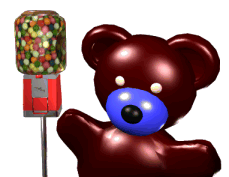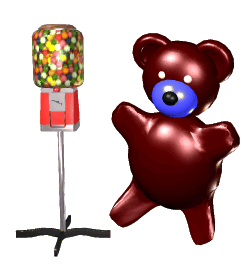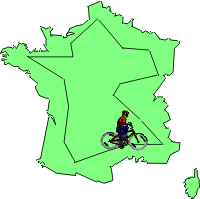

 |
 "Hi! I'm here with Amanda Bear today
to talk about the Commutative
Property of Addition. We're going
to use this gum ball machine to demonstrate that buying a gum
ball from a machine is not commutative." "Hi! I'm here with Amanda Bear today
to talk about the Commutative
Property of Addition. We're going
to use this gum ball machine to demonstrate that buying a gum
ball from a machine is not commutative." |
 |
"Amanda wants some gum from this machine. Before she can get it; she must first put money into the machine. This is not a commutative operation. If it were, Amanda could get the gum ball and then put the money in the machine." |
|
"But if I use a hammer, the operation is commutative. I can get as many gumballs as I want and I don't have to pay for them if I don't want to." |
"No! No! Amanda Your wrecking the demonstration. Oh well, read below for more on the Commutative Property." |
|
|
To find the total for the first three days
of the Tour, Victor would add
5.6 km + 180.5 km + 205.5 km. Following
the rules for Order of Operations, we would do these additions
from left to right. However, since they are all additions, we
can do them in any order and still get the same answer. Associative Property of Addition. |
 duane hyde |
|
(5.6 + 180.5) +205.5 = 5.6 + (180.5 + 205.5) 186.1 + 205.5 = 5.6 + 386 391.6 = 391.6 |
|
The Commutative Property (changing the order of the numbers) and the Associative Property (changing the order of the additions) are important because they allow us to easily simplify expressions which contain only addition. In the example above, the right side of the equation is easier because you can combine the second two decimal numbers into a whole number. |
|
Because addition is commutative and
associative, for any expression involving only addition,
you can change the order of addends and add parentheses whenever
you desire.
 |
Here is a page from Victor's racing journal. Tell which property he used to calculate the distance he rode: Stage 3 = 169 km Stage 4 = 252 km Stage 5 = 228.5 km Stage 6 = 204.5 km A: Total for stages 3 & 4: 169 + 252 = 252 + 169 = 421 B: Total for stages 3, 4, & 5: 169 + 252 + 228.5 = 169 + (252 + 228.5) = 649.5 C: Total for stages 4, 5, & 6: 252 + (228.5 + 204.5) = 252 + (204.5 + 228.5) = 685 |
| Written by: Nikki Siegel | Art by: Duane Hyde and Travis Spaid |